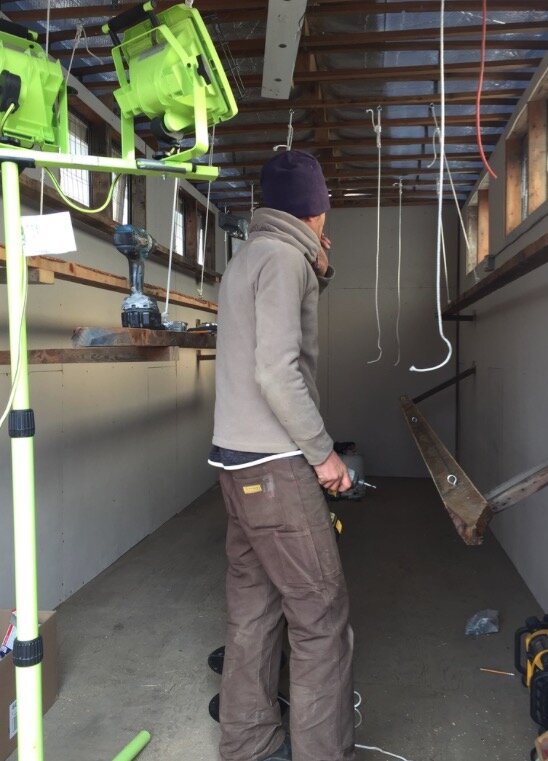Greens in the tunnels are still being harvested, mostly when we have windows to wash and pack.
Happy winter, Farm Friends.
The winter Solstice arrives this weekend, and for the first time ever we'll celebrate the longest night of the year with a meal that includes a pile of fresh greens. We hope you'll do the same. The farmstore was stocked Wednesday with fresh spinach, baby kale, boc choi, and tatsoi, as well as carrots, potatoes, and plenty of squash and garlic.
As we enter winter, our theoretical resting-season, and the hum of the holiday season surrounds us, we face our usual dilemma of being, well, pretty bad at taking time off. It's a common problem for farmers, and maybe all small business owners whose job is also their passion. It can be almost comical, as we have only half-joking discussions of whether a double-axel trailer can be considered a Christmas gift, or whether the innovative addition of hinging roost bars, power outlets, insulation, and adding a fresh coat of paint to a chicken barn counts as festive decorating. You'll be glad to know we determined "no" on both counts. But still, it can feel like it takes a bit of active effort to keep the grinch off the farm, with such big lists of goals and necessary season-ending chores still to wrap up. The infrastructure and improvement goals are a bit overwhelming, and it can be hard to stop for a break.
We're working on it though, and as with many things in farming, it's helpful to know that we are not alone. Chatting with fellow members of our grower's co-op social this fall, we were inspired by farmers who were preparing to take not just days, but weeks of winter to travel, rest, and explore. We were also heartened, in a way, to hear them confirm "it does take practice!" One confessed that it takes him a full week of their month-long vacation before he gets over being "kind of mad to not just be at the farm working on stuff."
Last week, we tried unsucessfully to take a weekend. The effort began with a long discussion of what exactly "a weekend" means, and what was necessary in order to make it reality. We started with good intentions, but little experience. We hadn't had a weekend all year, and the last time we could remember two days "off" in a row was going to an intensive farmer-conference and a friend's wedding last winter. And so, when an opportunity came up on Saturday to see some farmer colleagues' wash and pack warehouse before they left the country for a while, we jumped on it. Through a festive flurry of snow, we drove up to Arlee, and tromped through fields, high tunnels, prophouses, and warehouses. It was fun, but also definitevely work-related. And then we spent another hour or so with them, afterwards, talking at their farm kitchen table.
It's a funny fine line--we promised ourselves a lunch date in Missoula, to make it weekend-y even though this was clearly farm-business reasearch. But we ended up visiting with our farmer friends for hours because in reality none of us wanted to stop talking about farming. In the growing season, we never have time to visit each other, or if we manage to, there are hard planting and harvest deadlines, everyone needing to rush to the next thing. With the snow falling, we had the luxury of comparing notes on manure and fertilizer sources, lettuce varieties, washing methods, new tools, how to find employees, what temperature to store green peppers at, and all manor of things that "normal" people, lovely as you all are, would probably not be excited about. The solidarity of our colleagues does matter, and again, to hear our peers admit to also being burnt out at this time of year, despite many successes in the season, helped us feel not so alone.
Between that visit, the regular chores, and realizing Sunday was the deadline for a group order on supplies that saves us quite a bit of money, we arrived at Sunday evening feeing like about all we had to show for our supposed weekend was a Friday night dinner and movie with friends, and having scrubbed both the kitchen sink and the shower (kind of a big deal, actually). We're going to try again. Surely we can get better at this, too.
In other farm news...the class of 2020 hens continue to grow, but are still two months from laying any eggs. The 90-ish actively laying hens are going strong, but can't meet all of your demands, so please remain patient. They are enjoying their newly remodeled digs, but since they were moved after dark, may not even fully understand that they gave up the biggest barn, which is, as I write, being scrubbed, upgraded, and prepared for move-in of half of the youngest flock.
With the big chicken housing shuffle, and the continued harvests, we will not have our 2020 membership signups ready in December, the original goal. But don't worry, we'll be ready for signups sometime in January, as you start to think about healthy habits and delicious vegetables. Past members will have a first shot at registration, so members, be sure to watch your emails! We've already started many of the purchases, tool making, and investments for the 2020 season, with hours of crop planning and seed orders coming soon. We think, honestly, it's going to be our best season yet and we hope you'll join us.
Course materials came this week for the winter homework that will help bring our flower-growing to the next level. You can support this by purchasing a pre-paid flower card now, to spend over the summer and fall.
flower credit, and will help cover the cost of the farm's registration in an intesive online flower-growing workshop from Floret Farms this winter. This was a big investment this fall in an effort to bring our flower growing up to the level of our vegetable production. The flowers bring so much beauty and joy to the farm, and to appreciative customers, but it's the area of least expertise and training in our farming, and was in need of a little focused attention. To help us get there, and give yourself a season of fresh, pre-paid blooms to look forward to, just click this link to purchase through the website, where you can let us know if you'd like to stop by the farmstore to pick up your card, or have it mailed to you.
Winter breakfast: leftover baked squash in oatmeal with cinnamon, walnuts, maple syrup and yogurt. Best eaten near the wood stove.
And finally, a little glimpse at the winter-farm table lately: baked delicata squash with chopped spinach salads inside (add dollops of goat cheese, toasted walnuts, and a balsamic dressing), roasted cubed potatoes drizzled with herb butters, curried squash soups, carrot-and-cabbage salads, mashed potatoes of all colors, curries topped with raw boc choi and tatsoi, and chicken soup. We hope you are eating well as well. Even as we work on getting more of the farm wrapped up for winter, we'll be here farming, and we thank you as always for being a part of it.
With gratitude and wishing you winter peace,
Mary and Noah
































